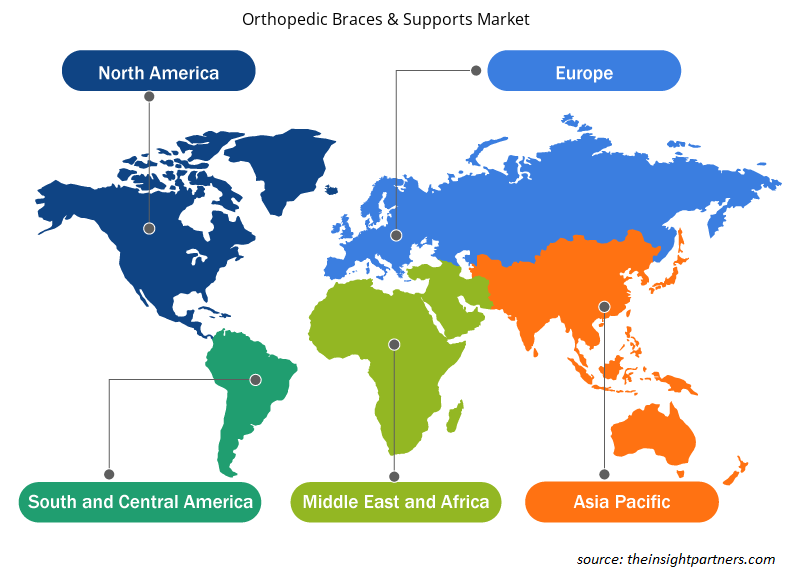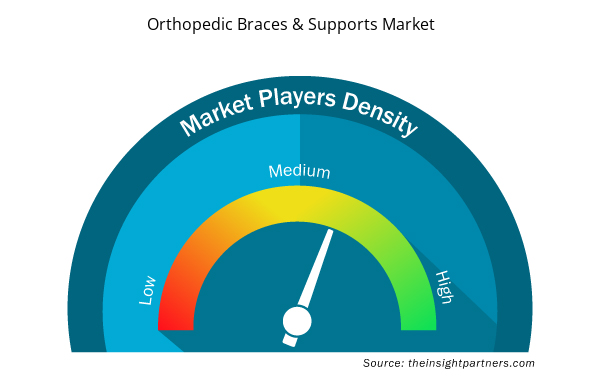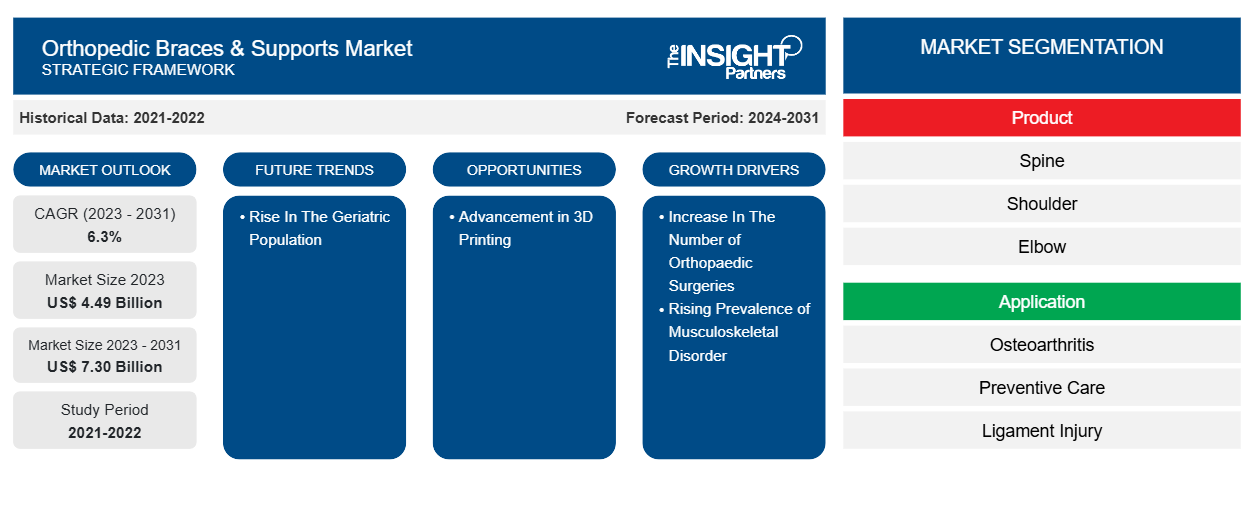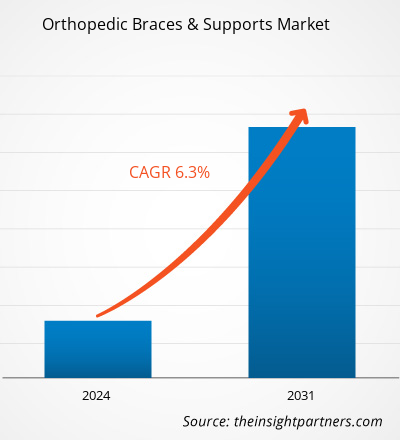Si prevede che il mercato dei tutori e dei supporti ortopedici raggiungerà i 7,30 miliardi di dollari entro il 2031, passando dai 4,49 miliardi di dollari del 2023. Si prevede che il mercato registrerà un CAGR del 6,3% nel periodo 2023-2031. Lo sviluppo tecnologico, come l'adozione di software di modellazione anatomica e materiali ipoallergenici per una migliore accuratezza ed efficienza nella progettazione del prodotto, rimarrà probabilmente una tendenza chiave nel mercato.
Analisi di tutori e supporti ortopedici
Il mercato dei tutori e dei supporti ortopedici è guidato da miglioramenti tecnologici, da un aumento del numero di infortuni sportivi e correlati ad incidenti, da un aumento della popolazione geriatrica e da una crescente consapevolezza pubblica dei trattamenti preventivi. Queste variabili aiutano a produrre beni e soluzioni creativi che migliorano i risultati per i pazienti. Ad esempio, secondo il Population Reference Bureau, il numero di persone di età pari o superiore a 65 anni negli Stati Uniti aumenterebbe da 58 milioni nel 2022 a 82 milioni entro il 2050. L'incorporazione di consulenze ortopediche e raccomandazioni sui dispositivi nelle piattaforme di telemedicina e la domanda di tutori e supporti ortopedici personalizzati rappresentano un'opportunità in espansione.
Panoramica sui tutori e supporti ortopedici
I tutori ortopedici e i prodotti di supporto sono utilizzati per la riabilitazione da infortuni, la prevenzione degli infortuni, la cura dell'osteoartrite, la cura post-operatoria e altro ancora. I tutori e i supporti sono disponibili sotto forma di tutori per ginocchia , caviglie, gambe, gomitiere, gomitiere del tennista, polsi, stecche per pollice e mano, tutori per collo, schiena e spalle e altro ancora. Inoltre, gli atleti utilizzano regolarmente tutori ortopedici per prevenire infortuni e aiutare nel processo di recupero. La crescente preferenza dei pazienti per le opzioni di trattamento non invasive rispetto alla chirurgia sta aumentando la domanda di prodotti e fornisce una soluzione non chirurgica per un'ampia gamma di disturbi muscoloscheletrici. Secondo il CDC, l'osteoartrite colpisce oltre 32,5 milioni di adulti negli Stati Uniti. I tutori per l'osteoartrite possono aiutare a migliorare i sintomi, la mobilità, la funzionalità e la qualità della vita.
Personalizza questo report in base alle tue esigenze
Riceverai la personalizzazione gratuita di qualsiasi report, comprese parti di questo report, o analisi a livello nazionale, pacchetto dati Excel, oltre a usufruire di grandi offerte e sconti per start-up e università
- Scopri le principali tendenze di mercato in questo rapporto.Questo campione GRATUITO includerà analisi di dati che spaziano dalle tendenze di mercato alle stime e alle previsioni.
Driver e opportunità per tutori e supporti ortopedici
La crescente prevalenza di disturbi muscoloscheletrici favorirà il mercato
La crescente prevalenza di disturbi muscoloscheletrici , così come la crescente popolazione geriatrica, aumentano la domanda di procedure ortopediche. Ad esempio, secondo un articolo del settembre 2021 del Journal of Orthopaedic Science, entro il 2030 in Giappone saranno eseguite circa 4052 artroplastiche del ginocchio su uomini di età compresa tra 40 e 64 anni, 6942 su uomini di età compresa tra 65 e 74 anni e 14.986 su uomini di età pari o superiore a 75 anni. Inoltre, secondo il National Safety Council, negli Stati Uniti nel 2022 sono stati segnalati circa 440.000 infortuni dovuti ad esercizi e attrezzature per esercizi. Pertanto, il previsto aumento delle operazioni all'anca e al ginocchio nella popolazione aumenta la domanda di tutori e supporti che aiutino i pazienti a camminare, spingendo in avanti il mercato.
Progressi nella stampa 3D
I progressi nelle tecnologie di stampa 3D e scansione digitale hanno reso possibile la progettazione di dispositivi ortopedici su misura in base all'anatomia e alle esigenze di un individuo. Gli operatori sanitari utilizzano scansioni digitali della colonna vertebrale di un paziente per produrre modelli 3D dettagliati che guideranno il processo di stampa. La personalizzazione migliora il comfort del paziente e i risultati del trattamento, rendendola un'enorme opportunità commerciale.
Analisi della segmentazione del rapporto sui tutori e supporti ortopedici
I segmenti chiave che hanno contribuito alla derivazione dell'analisi dei tutori e dei supporti ortopedici sono il prodotto e l'applicazione.
- In base al prodotto, i tutori e i supporti ortopedici sono segmentati in ginocchio, schiena e anca, spalla, gomito, piede, caviglia e colonna vertebrale. Il segmento del ginocchio ha detenuto la quota di mercato maggiore nel 2023.
- Per applicazione, il mercato è segmentato in lesioni ai legamenti, osteoartrite, cure preventive, tutori a freddo e altri. Il segmento delle lesioni ai legamenti ha detenuto la quota maggiore del mercato nel 2023.
Analisi delle quote di tutori e supporti ortopedici per area geografica
L'ambito geografico del rapporto sui tutori e supporti ortopedici è suddiviso principalmente in cinque regioni: Nord America, Asia Pacifico, Europa, Medio Oriente e Africa, Sud e Centro America.
Il Nord America ha dominato il mercato. La crescita del mercato nella regione è attribuita alla crescente popolazione geriatrica, ai crescenti sviluppi da parte degli operatori del mercato per tutori e supporti ortopedici, alla crescente consapevolezza sulla disponibilità del prodotto e alla crescente adozione di tutori ortopedici per offrire mobilità e prevenire ulteriori lesioni al legamento.
Ambito del rapporto sui tutori e supporti ortopedici
Approfondimenti regionali sul mercato dei tutori e dei supporti ortopedici
Le tendenze regionali e i fattori che influenzano il mercato dei tutori e dei supporti ortopedici durante il periodo di previsione sono stati ampiamente spiegati dagli analisti di Insight Partners. Questa sezione discute anche i segmenti e la geografia del mercato dei tutori e dei supporti ortopedici in Nord America, Europa, Asia Pacifico, Medio Oriente e Africa e Sud e Centro America.

- Ottieni i dati specifici regionali per il mercato dei tutori e dei supporti ortopedici
Ambito del rapporto di mercato sui tutori e supporti ortopedici
| Attributo del report | Dettagli |
|---|---|
| Dimensioni del mercato nel 2023 | 4,49 miliardi di dollari USA |
| Dimensioni del mercato entro il 2031 | 7,30 miliardi di dollari USA |
| CAGR globale (2023-2031) | 6,3% |
| Dati storici | 2021-2022 |
| Periodo di previsione | 2024-2031 |
| Segmenti coperti | Per Prodotto
|
| Regioni e Paesi coperti | America del Nord
|
| Leader di mercato e profili aziendali chiave |
|
Densità degli attori del mercato dei tutori e dei supporti ortopedici: comprendere il suo impatto sulle dinamiche aziendali
Il mercato dei tutori e dei supporti ortopedici sta crescendo rapidamente, spinto dalla crescente domanda degli utenti finali dovuta a fattori quali l'evoluzione delle preferenze dei consumatori, i progressi tecnologici e una maggiore consapevolezza dei benefici del prodotto. Con l'aumento della domanda, le aziende stanno ampliando le loro offerte, innovando per soddisfare le esigenze dei consumatori e capitalizzando sulle tendenze emergenti, il che alimenta ulteriormente la crescita del mercato.
La densità degli operatori di mercato si riferisce alla distribuzione di aziende o società che operano in un particolare mercato o settore. Indica quanti concorrenti (operatori di mercato) sono presenti in un dato spazio di mercato in relazione alle sue dimensioni o al valore di mercato totale.
Le principali aziende che operano nel mercato dei tutori e supporti ortopedici sono:
- DJO globale
- Zimmer Biomet
- Azienda Ossur
- 3 milioni
- Società a responsabilità limitata
- Felino del Bauer
Disclaimer : le aziende elencate sopra non sono classificate secondo un ordine particolare.

- Ottieni una panoramica dei principali attori del mercato dei tutori e supporti ortopedici
Notizie e sviluppi recenti su tutori e supporti ortopedici
I tutori e i supporti ortopedici vengono valutati raccogliendo dati qualitativi e quantitativi dopo la ricerca primaria e secondaria, che include importanti pubblicazioni aziendali, dati di associazioni e database. Di seguito sono elencati alcuni degli sviluppi nei tutori e nei supporti ortopedici:
- OrthoPediatrics Corp. ha acquisito Boston Orthotics & Prosthetics. Questa acquisizione consente a OrthoPediatrics Corp. di servire più pazienti come estensione della nostra strategia di crescita per circondare i clienti chirurghi ortopedici pediatrici con il portafoglio più completo di dispositivi di trattamento ortopedico pediatrico (Fonte: OrthoPediatrics Corp, comunicato stampa, gennaio 2024)
- dj Orthopedics, Inc., ha lanciato un nuovo sistema di rinforzo multifunzionale per la schiena, il BOA (Back Orthotic Appliance). Il BOA è progettato per affrontare una varietà di indicazioni cliniche spinali, tra cui il supporto post-operatorio dopo fusione spinale e laminectomia spinale, acuto e
- lombalgia cronica ed ernia o degenerazione del disco. (Fonte: dj Orthopedics Inc, comunicato stampa, settembre 2022)
Copertura e risultati del rapporto sui tutori e supporti ortopedici
Il rapporto "Dimensioni e previsioni di tutori e supporti ortopedici (2021-2031)" fornisce un'analisi dettagliata del mercato che copre le seguenti aree:
- Dimensioni e previsioni del mercato dei tutori e dei supporti ortopedici a livello globale, regionale e nazionale per tutti i principali segmenti di mercato coperti dall'ambito
- Tendenze del mercato dei tutori e supporti ortopedici, nonché dinamiche di mercato come driver, sistemi di ritenuta e opportunità chiave
- Analisi dettagliata delle cinque forze PEST/Porter e SWOT
- analisi di tutori e supporti ortopedici che copre le principali tendenze del mercato, il quadro globale e regionale, i principali attori, le normative e i recenti sviluppi del mercato
- Analisi del panorama industriale e della concorrenza che copre la concentrazione del mercato, l'analisi della mappa di calore, i principali attori e gli sviluppi recenti per i tutori e i supporti ortopedici
- Profili aziendali dettagliati
- Analisi storica (2 anni), anno base, previsione (7 anni) con CAGR
- Analisi PEST e SWOT
- Valore/volume delle dimensioni del mercato - Globale, regionale, nazionale
- Industria e panorama competitivo
- Set di dati Excel



Report Coverage
Revenue forecast, Company Analysis, Industry landscape, Growth factors, and Trends

Segment Covered
This text is related
to segments covered.

Regional Scope
North America, Europe, Asia Pacific, Middle East & Africa, South & Central America

Country Scope
This text is related
to country scope.
Domande frequenti
The market is estimated to grow at a CAGR of 6.3% during 2023–2031.
The estimated value of the market by 2031 will be US$ 7.30 billion.
DJO Global and Zimmer Biomet are the leading players operating in the intermittent catheters market.
Adoption of anatomical modelling software and hypoallergenic materials is likely to act as trends in the market in the future.
The rising prevalence of musculoskeletal disorder, increase in the number of sports and accident-related injuries, and a rise in the geriatric population are the factors bolstering the market.
North America dominated the market in 2023.
Trends and growth analysis reports related to Life Sciences : READ MORE..
The Insight Partners performs research in 4 major stages: Data Collection & Secondary Research, Primary Research, Data Analysis and Data Triangulation & Final Review.
- Data Collection and Secondary Research:
As a market research and consulting firm operating from a decade, we have published and advised several client across the globe. First step for any study will start with an assessment of currently available data and insights from existing reports. Further, historical and current market information is collected from Investor Presentations, Annual Reports, SEC Filings, etc., and other information related to company’s performance and market positioning are gathered from Paid Databases (Factiva, Hoovers, and Reuters) and various other publications available in public domain.
Several associations trade associates, technical forums, institutes, societies and organization are accessed to gain technical as well as market related insights through their publications such as research papers, blogs and press releases related to the studies are referred to get cues about the market. Further, white papers, journals, magazines, and other news articles published in last 3 years are scrutinized and analyzed to understand the current market trends.
- Primary Research:
The primarily interview analysis comprise of data obtained from industry participants interview and answers to survey questions gathered by in-house primary team.
For primary research, interviews are conducted with industry experts/CEOs/Marketing Managers/VPs/Subject Matter Experts from both demand and supply side to get a 360-degree view of the market. The primary team conducts several interviews based on the complexity of the markets to understand the various market trends and dynamics which makes research more credible and precise.
A typical research interview fulfils the following functions:
- Provides first-hand information on the market size, market trends, growth trends, competitive landscape, and outlook
- Validates and strengthens in-house secondary research findings
- Develops the analysis team’s expertise and market understanding
Primary research involves email interactions and telephone interviews for each market, category, segment, and sub-segment across geographies. The participants who typically take part in such a process include, but are not limited to:
- Industry participants: VPs, business development managers, market intelligence managers and national sales managers
- Outside experts: Valuation experts, research analysts and key opinion leaders specializing in the electronics and semiconductor industry.
Below is the breakup of our primary respondents by company, designation, and region:

Once we receive the confirmation from primary research sources or primary respondents, we finalize the base year market estimation and forecast the data as per the macroeconomic and microeconomic factors assessed during data collection.
- Data Analysis:
Once data is validated through both secondary as well as primary respondents, we finalize the market estimations by hypothesis formulation and factor analysis at regional and country level.
- Macro-Economic Factor Analysis:
We analyse macroeconomic indicators such the gross domestic product (GDP), increase in the demand for goods and services across industries, technological advancement, regional economic growth, governmental policies, the influence of COVID-19, PEST analysis, and other aspects. This analysis aids in setting benchmarks for various nations/regions and approximating market splits. Additionally, the general trend of the aforementioned components aid in determining the market's development possibilities.
- Country Level Data:
Various factors that are especially aligned to the country are taken into account to determine the market size for a certain area and country, including the presence of vendors, such as headquarters and offices, the country's GDP, demand patterns, and industry growth. To comprehend the market dynamics for the nation, a number of growth variables, inhibitors, application areas, and current market trends are researched. The aforementioned elements aid in determining the country's overall market's growth potential.
- Company Profile:
The “Table of Contents” is formulated by listing and analyzing more than 25 - 30 companies operating in the market ecosystem across geographies. However, we profile only 10 companies as a standard practice in our syndicate reports. These 10 companies comprise leading, emerging, and regional players. Nonetheless, our analysis is not restricted to the 10 listed companies, we also analyze other companies present in the market to develop a holistic view and understand the prevailing trends. The “Company Profiles” section in the report covers key facts, business description, products & services, financial information, SWOT analysis, and key developments. The financial information presented is extracted from the annual reports and official documents of the publicly listed companies. Upon collecting the information for the sections of respective companies, we verify them via various primary sources and then compile the data in respective company profiles. The company level information helps us in deriving the base number as well as in forecasting the market size.
- Developing Base Number:
Aggregation of sales statistics (2020-2022) and macro-economic factor, and other secondary and primary research insights are utilized to arrive at base number and related market shares for 2022. The data gaps are identified in this step and relevant market data is analyzed, collected from paid primary interviews or databases. On finalizing the base year market size, forecasts are developed on the basis of macro-economic, industry and market growth factors and company level analysis.
- Data Triangulation and Final Review:
The market findings and base year market size calculations are validated from supply as well as demand side. Demand side validations are based on macro-economic factor analysis and benchmarks for respective regions and countries. In case of supply side validations, revenues of major companies are estimated (in case not available) based on industry benchmark, approximate number of employees, product portfolio, and primary interviews revenues are gathered. Further revenue from target product/service segment is assessed to avoid overshooting of market statistics. In case of heavy deviations between supply and demand side values, all thes steps are repeated to achieve synchronization.
We follow an iterative model, wherein we share our research findings with Subject Matter Experts (SME’s) and Key Opinion Leaders (KOLs) until consensus view of the market is not formulated – this model negates any drastic deviation in the opinions of experts. Only validated and universally acceptable research findings are quoted in our reports.
We have important check points that we use to validate our research findings – which we call – data triangulation, where we validate the information, we generate from secondary sources with primary interviews and then we re-validate with our internal data bases and Subject matter experts. This comprehensive model enables us to deliver high quality, reliable data in shortest possible time.


 Ottieni un campione gratuito per questo repot
Ottieni un campione gratuito per questo repot